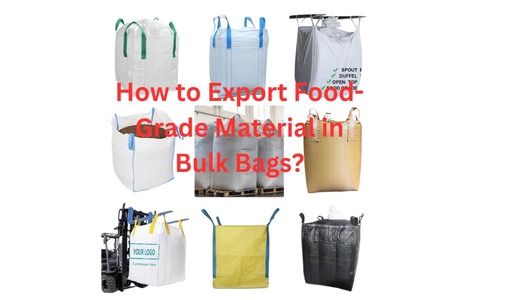
Bulk bag export of food-grade products presents possibilities and difficulties during processing. This reasonably priced and quick approach requires exacting attention to detail to guarantee product safety and international standard compliance.
By providing efficiency and cost-effectiveness, bulk bags have transformed the food sector by simplifying complexity. However, guaranteeing the safe movement of food-grade products in these big containers requires a thorough knowledge of food safety laws, packaging standards, and logistics.
This guide will provide you with the fundamental information to navigate the difficulties of exporting food-grade products in bulk bags, from choosing the right packaging to following international regulations. Let us travel together to investigate the subtleties of this essential procedure.
Understanding the Importance of Food-Grade Bulk Bags
Gravitas Packaging makes food-grade bulk packaging or FIBC bags to move food goods without sacrificing safety or quality. We follow strict hygienic standards and ensure these bulk bags are produced in regulated surroundings. Using these bags provides several benefits:
- Cost-Effective: Bulk transportation is generally more affordable than shipping smaller goods.
- Efficient: Effective load and unload times help to simplify the supply chain.
- Space-Savings: Bulk bags save more room than individual parcels.
Environmental Friendly: Reduces packaging waste and moves enormous quantities in a small area, thereby becoming environmentally beneficial.
Choosing the Right Bulk Bag
Gravitas Packaging provides several industrial choices. Choosing a suitable bulk bag is essential. These are the salient features to remember while selecting the appropriate bulk bag for your industrial purpose.
Material: First, ensure the food-grade bags are suitable for the goods carried. The choice of the one for shipping products depends much on the content.
Size and Capacity: Gravitas Packaging creates several bulk bags using different materials with a designated volume. Based on weight and product volume, get the ideal proportions to move your goods effectively.
Construction: Choose a bag suitable for your handling needs based on its shape—a circle or a square.
Liners: Depending on the good, an inner liner might be required to stop contamination.
Certifications: Ensure the bags follow pertinent food safety guidelines (BRC, FDA, EU).
Preparing Your Food-Grade Material
Make sure your food-grade material satisfies the following before loading the bulk bags:
- Quality Control: Evaluate product purity and safety through thorough quality control.
- Moisture Content: Maintaining ideal moisture content will help to prevent clumping and spoiling.
- Particle Size: Double-check that the size is constant to prevent obstructions.
Sealing and Filling the Bulk Bags
Product integrity depends on correct filling and sealing:
- Filling Equipment: Using hygienic, sanitized tools will help to prevent contamination.
- Filling Density: Maximize bag capacity by optimizing filling density, preserving product quality without sacrificing anything.
- Sealing: You can guarantee a strong closing by using suitable sealing techniques, such as heat sealing or stitching.
Weight Verification: To follow laws, precisely weigh every filled bag to avoid hustle.
Proper Handling and Transportation Safety
Firstly, the priority is keeping your food-grade substance safe on the route. A few guidelines help you make your transportation safe.
- Transport Vehicles: Use enclosed, clean trucks to protect the bags from outside pollution.
- Load and Unload: Use bags gently to avoid breakage and product leaks.
Storage: Keep your bags somewhere dry, clean, and free from pests and severe temperatures.
Compliance with Regulation
Adhering to export rules and food safety criteria when handling food-grade materials in bulk bags is not just a requirement but a responsibility.
- Food Safety Criteria: Follow pertinent guidelines (HACCP, ISO 22000).
- Export Documentation: To prevent mishaps, create precise and complete shipment documentation, including commercial invoices, packing lists, and certificates of origin.
- Labeling: Tag the bags with weight, handling directions, and product information to redirect to the exact location in case you miss any.
Customs Clearance: Understand and follow customs laws in nations while exporting and importing goods.
Collaborating with Trustworthy Vendors
Regarding packaging, partnering with reliable bulk bag suppliers and shipping companies is not just a good idea; it’s necessary to ensure product safety and peace of mind.
- Supplier Selection: Choose vendors, like Gravitas Packaging, with a demonstrated food-grade packaging history.
- Quality Assurance: Engage with the compliance supplier is followed for food safety criteria.
Logistics Expertise: Choose a logistics partner knowledgeable in managing food-grade products.
Constant Enhancement
The food business is ever-changing. Keep your consumers informed about the newest rules and trends to update them about compliance.
- Industry News: Track publications from the sector and go to pertinent conferences.
- Regulatory Updates: Keep regulatory updates with changes in food safety and export rules.
Customer Feedback: Comments help you pinpoint areas for development. Stay vigilant about your customers’ responses to a particular change.
By following these rules and being strongly dedicated to food safety, you can export food-grade products in bulk bags effectively, safeguarding your brand name and guaranteeing customer happiness.



Recent Comments